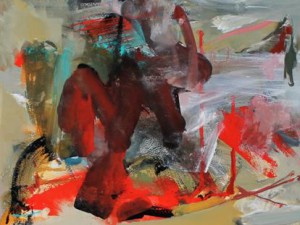An interview with artist (and past student) Julie D Cooper
Julie is a past student of Insight School of Art. Last week Trainee Manager Charlotte Milburn learnt that Julie had just been elected an Associate member of the Royal Watercolour Society so she caught up with Julie to ask her a few questions about her recent success, as well as getting some advice on how to become a successful artist.
CM :When did you become interested in art? Where did it all start?
JC: I became interested in art on my first day at Insight School of Art. I enrolled on the beginners course inn 2004 and continued attending their leisure painting courses in acrylic, oil and pastels. I attended a variety of invaluable workshops on a regular basis.
CM: Where did you study art? What were the most important lessons you learnt?
JC: I have no fine art degree. My education evolved through my time at ISoA. I painted figuratively for five years and with the encouragement and guidance from Paul Regan I was able to develop my practice and pursue my personal abstract language. The most important lessons I learnt is ‘not everybody will like your work’ and be confident.
CM: How would you describe your work?
JC: My paintings are direct feelings and visual associations of the Cornish landscape. They are multi-layered and deep rooted with the medium of paint. I am trying to investigate a variety of spatial depth through colour, form and line, a personal focus. Colours are less important when I start. It is the way they are applied which gives meaning.
CM: Which artists inspire you most and how do they influence your own work?
JC: Initially John Hoyland, Albert Irvin and Howard Hodgkin, but more recently Gary Wragg. My practice is a private and personal experience, I try not to be influenced by other artists. I am interested in the workings of a painting, scraping back, repainted and the physical act of making work. I spend one week a month in St Ives, Cornwall. I am deeply affected by Lanyon, Heron, Hilton, Hepworth in fact too many artists to mention, who painted in the 1940/50 who were completely ahead of their time. Their art was revolutionary in St Ives, it became the major centre of the Modern Movement in British Art for a few years.
CM: Where can people see your work? Are you involved in any upcoming exhibitions? And do you have a website?
JC: At present two works on paper can be seen at The Royal Watercolour Society’s annual spring exhibition.
‘Watercolour Etc’
Bankside Gallery
London SE1
27/3 – 25/4
Julie’s upcoming joint exhibition
Edge of Colour
The Crypt Gallery, St Ives, Cornwall
18/4 – 24/4
CM: What is involved in working professionally as an artist? And what advice would you give to artist wanting to exhibit and sell their work?
JC: Discipline, I paint most days. At times it can be quite solitary and challenging, difficult decisions have to be made. I question myself all the time. Believe in what you do, be serious as you will be making investments in materials and framing. Never think, ‘That will do’, it’s never just about composition, it is the potential of meaning and investigation, many levels of interpretation.
A website is essential and social networking is an excellent tool. I am a great fan of Twitter 140 characters a great way to interact with fellow artists. Applications for the majority of Annual Open Exhibitions are initially online, so good quality photographs of your work are essential. Above all effort and perseverance are required.
CM: Do you have a studio that you work in? Where do you paint?
JC: I have a purpose built timber studio in my garden in St Albans, it’s insulated with lighting and running cold water. It’s a great space to paint and evaluate my work. I must admit rather messy as I like my studies and sketches on the floor. Also, I have a studio in St Ives, two metres from the sea with surrounding views of St Ives Bay.
CM: You have just been elected associate member of the Royal Watercolour Society. How does an artist get elected and what does being a member entail?
JC: Anybody can apply. I have successfully been selected for the annual Contemporary Watercolour Competition, an open exhibition held at the Bankside Gallery, run by the RWS for the last three years. Last year I was encouraged to make an application for Membership of the Society. I did apply and was unsuccessful. This year I was thrilled to be elected. You are invited to submit three framed paintings and a portfolio of supporting work to be judged by the RWS members. I am entitled to show in the two main exhibitions of the year and two exhibition the RWS share with the RE (The Royal Society of Painters-Printmakers) in the Summer and at Christmas.

Leave a Reply